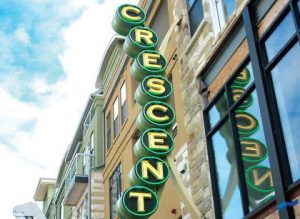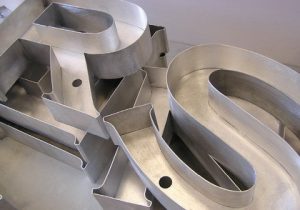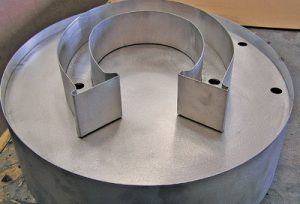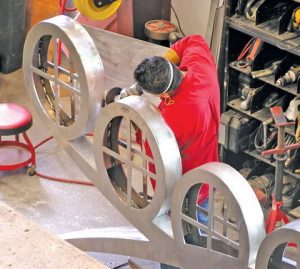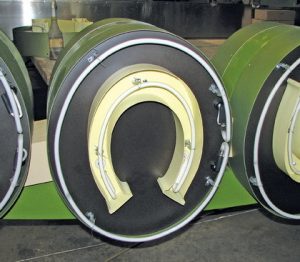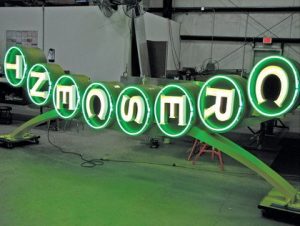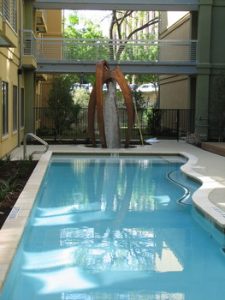Electric Signs
The Crescent Role
Ion Art creates signage and sculptures that fortify a new development
Published
15 years agoon
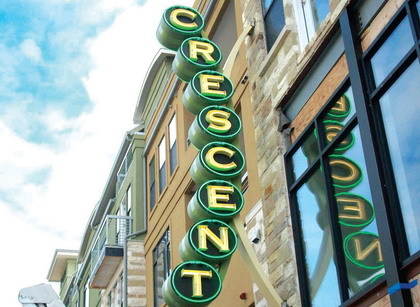
Austin, TX is known as the live-music capital of the world, but numerous other amenities make it a great place to live. The city and its surroundings offer a beautiful setting where the terrain of central and west Texas’ expansive Hill Country intersects with many lakes and rivers.
But, perhaps more importantly, career opportunities, a top-tier university and public-education system, and relatively affordable housing also elevate Austin consistently in quality-of-life rankings among U.S. cities.
Ion meets Crescent
Many projects never reach fruition because a proposal’s complexity requires niche expertise from several companies. Unless very tightly controlled, enlisting many companies for one project can lead to cost overruns and delays that can easily scuttle a project before it begins. With a state-of-the-art production facility and a talented, 24-person staff, Ion Art can handle design, engineering, fabrication, permitting and installation. Value engineering plays a key role in developing cost-effective solutions.
Riverside Resources, an Austin-based developer that manages properties with an emphasis on modern art and natural environments, presented such a challenge with the Crescent, a multi-use, retail and residential development nestled in the heart of downtown Austin.
AdvertisementAs a high-profile, ambitious adventure, the Crescent development would require not only a cutting-edge sign package, but also innovative decor. John Needham and Sam Laine, owner and project manager for Riverside Resources, a real-estate developer, sought an organization that could create a “wow factor.” Through word of mouth, they contacted Ion Art and met with Sharon Keshishian (our president) and Paul Ross (the creative director). Riverside’s primary goals for the property’s environmental graphics included a prominent, exterior sign and a unique, freestanding sculpture for the pool area – all while meeting the allotted budget.
The icon
Most sign designs require simplifications during the creative process. But, in this case, Ion Art conducted many meetings and produced numerous renderings in pursuit of that “wow factor.” Ross began every design as a pencil sketch before developing it with a medley of creative software – we used Adobe® Illustrator® CS2 and Photoshop® CS2 for layout and preliminary design concepts, and finalized shop drawings with CAD Tools. Sketch-Up Pro aided building each design within 3-D space; this program provides an excellent tool for the development phase.
Ion Art worked closely with Riverside during the creative process. We settled on a primary projecting sign, which required quite a metamorphosis to reach the final design. The project features a vintage feel; we built a 9-ft.-tall sign with open-face channel letters and fastened exposed neon to individual drums that flow outward in the shape of a crescent.
AdvertisementWe fabricated the frame from ¼-in.-thick aluminum, which we shaped on our 6 x 12-ft. MultiCam 3000 Series CNC router. Adam Jorgenson, our router operator, used SA Intl.’s EnRoute™ 3 Pro to run each program. To create the frame and drum series, our welder, Ricardo Gonzales, quickly welded the aluminum forms into shape. The frame connects the C-channel spine to oval frames that house multiple, Lecip solid-state transformers.
For the ovals, we used Voltarc 15mm tubing; the 13mm letters incorporate EGL’s CL Designer Series 30 tubing. Attached to the framework on both sides, the 16 drums each support a channel letter and a ring of exposed neon. LEDs weren’t an option; the client wanted an authentic, vintage look.
Our paint department applied a five-color sequence to the blade sign using our Aero Tech Spray Systems Deluxe front-flow, automotive spraybooth. Using Matthews paint and a vacuum-base system, Jason Elliott expertly applied the satin-finish paints, which is unusual in the sign industry, where glossy finishes are the norm.
Making the vision real
In addition to the two primary sign elements, Ion Art created a complete interior-signage package with the same design emphasis. Our work yielded a crescent moon with exposed neon that is hung on the east-facing tower and can be seen for miles.
Advertisement
The complementary sign package includes a leasing-center sign with interchangeable plaques and Etchmark window vinyl; a site directory; illustrated floor plans at each elevator; and restaurant, pool and maintenance-room signage, among other types. We built the signs using an aluminum backer painted with custom-mixed Matthews acrylic polyurethane paint, thick acrylic sheet affixed to the metal with architectural standoffs, and hand-applied vinyl graphics. The directories, floor maps and amenity signage required rolling the aluminum to create a crescent shape and custom-fitting the attaching standoffs.
Riverside Resources was very pleased with the end result. With good reason, we believe Ion Art literally hung the moon with the Crescent. The project spanned 14 months from our initial meeting with Riverside to the first sign-installation phase. Now, we’re also developing signage for the Quarry, another Riverside mixed-use complex. This confirms our belief that happy customers inevitably generate more quality projects.
Water works
Our next, and most daunting, task required designing and constructing the freestanding, sculptural water feature that highlights the pool courtyard. The pool, unfortunately, neighbors the parking garage. Therefore, we needed to counteract that bustle with the water’s gentle babble. This presented quite a challenge.
Concocting preliminary designs required many hours of research and development. After the first meeting, Riverside selected a rough sketch of a highly sculptural, modern concept that we hadn’t intended for presentation. However, we eagerly accepted the challenge. Ross’ design encapsulates water’s natural properties and achieves the Crescent logo with two entwined arches. Many additional hours of renderings preceded our development of a beautiful sculpture and functional water feature.
Ross used Adobe Illustrator CS2 with CAD tools and Sketch-Up Pro to refine the design and create shop drawings. His efforts yielded a 12-ft.-tall, freestanding sculpture built with a stainless-steel truss frame and a bead-rolled copper skin. Ion Art chose to use copper for its aesthetic appeal and corrosion resistance.
We cut the stainless-steel tubing on our cold saw and rolled it using our electric-tubing roller. Using a MIG welder, we assembled the tubing into support trusses. We rough-cut the copper skin on our CNC router and then finished it with our crank-operated bead roller. Finally, we hand-fitted the copper onto the truss and fastened it with copper rivets.
Ion Art carefully assessed exactly how much copper would be needed to skin the curved frame, which was very difficult. Using CAD Tools, we carefully drew sections that we broke into schematics of 10, 4 x 10-ft., copper sheets. Next, we exported the file into EnRoute® 3 CAD/CAM software to be machined on our CNC router.
To bring the water feature to life, we also router-cut two, MDF patterns to scale. The laid out, 12-ft. patterns created a silhouette for Sebastian Caillabet to fabricate the truss system out of stainless steel, 2-ft.-diameter pipe. Over several weeks, the sculpture evolved into two, distinct, crescent shapes.
We bead-rolled copper pieces before hammering and riveting them to the frame. To make the skin look as seamless as possible, while producing a low, steady water flow, Sebastian fabricated custom-fitted nozzles that we strategically positioned along the copper skin. We inserted flexible, rubber tubing within the nozzles to deliver the water.
We designed the entire structure to fit as a sleeve over a pre-made, aluminum base installed onsite during the initial fabrication phase. The aluminum base rests in a custom basin that Ion Art planned and designed well in advance to coincide with the pool’s construction.
The basin also features four exterior, waterproof floodlights and smooth river stones – tenants and visitors can walk and sit beneath it To combat the noise pollution, we selected a single, geyser-like fountain nozzle, concealed beneath the stones, which will spray straight up through the sculpture’s center.
More About Ion Art
In 1986, Greg and Sharon Keshishian founded Ion Art in Austin, TX. The shop fabricates a broad array of electric signage, environmental graphics and interior décor. The Keshishians and their staff enjoy plying their trade in Austin because many business owners in the eclectic, progressive city seek bold or unusual signage.
Greg said “Combining great artistic design with the structural and technical fabrication required to build a sign’s components is an art form unto itself.”
The Keshishians faced a crossroads in 1996, when a fire consumed their first shop. “We weren’t insured, and we lost nearly everything. After this trauma, we saw the best in people; many friends and sign-industry professionals came forward and helped us. Almost every negative event can be overcome with hard work and perseverance,” Greg said.
Since then, the company has grown and expanded into the design and fabrication of sculptures, water features and architectural décor. Greg said repeat customers and referrals generate nearly 90% of its business; they don’t advertise or employ a salesperson.
“Heavy growth isn’t part of our business plan,” Greg said. “We’d prefer to produce high-quality work and cherry-pick the best opportunities.”
Greg Keshishian and Paul Ross are, respectively, Ion Art's co-owner and creative director.

SPONSORED VIDEO
Introducing the Sign Industry Podcast
The Sign Industry Podcast is a platform for every sign person out there — from the old-timers who bent neon and hand-lettered boats to those venturing into new technologies — we want to get their stories out for everyone to hear. Come join us and listen to stories, learn tricks or techniques, and get insights of what’s to come. We are the world’s second oldest profession. The folks who started the world’s oldest profession needed a sign.
You may like

4 of the Most Fun Sign Projects in Years

Sign Pro’s Phrase Coaches Customers with Bad Ideas

2024 Sign Contest Open for Submission
Subscribe

Bulletins
Get the most important news and business ideas from Signs of the Times magazine's news bulletin.
Most Popular
-

 Paula Fargo2 weeks ago
Paula Fargo2 weeks ago5 Reasons to Sell a Sign Company Plus 6 Options
-

 Real Deal1 week ago
Real Deal1 week agoA Woman Sign Company Owner Confronts a Sexist Wholesaler
-

 Photo Gallery2 weeks ago
Photo Gallery2 weeks ago21 Larry Albright Plasma Globes, Crackle Tubes and More
-

 Projects1 week ago
Projects1 week agoGraphics Turn an Eyesore Cooler Into a Showpiece Promo in Historic Plaza
-

 News1 day ago
News1 day ago2024 Sign Contest Open for Submission
-

 Business Management1 week ago
Business Management1 week ago3 Things Print Pros Must Do to Build Stronger Relationships in the Interiors Market
-

 Projects18 hours ago
Projects18 hours ago4 of the Most Fun Sign Projects in Years
-
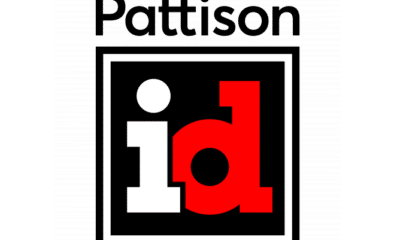
 News1 week ago
News1 week agoPattison ID New Name of Five Companies
